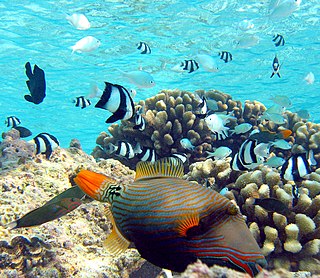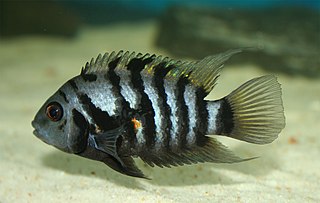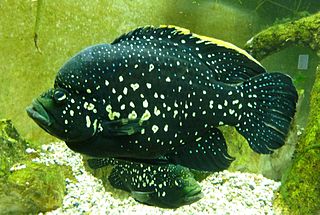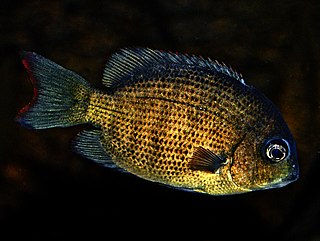
Cichlids are fish from the family Cichlidae in the order Cichliformes. Traditionally Cichlids were classed in a suborder, the Labroidei, along with the wrasses (Labridae), in the order Perciformes, but molecular studies have contradicted this grouping. On the basis of fossil evidence, it first appeared in Argentina during the Early Eocene epoch, about 48.6 million years ago; however, molecular clock estimates have placed the family's origin as far back as 67 million years ago, during the late Cretaceous period. The closest living relative of cichlids is probably the convict blenny, and both families are classified in the 5th edition of Fishes of the World as the two families in the Cichliformes, part of the subseries Ovalentaria. This family is large, diverse, and widely dispersed. At least 1,650 species have been scientifically described, making it one of the largest vertebrate families. New species are discovered annually, and many species remain undescribed. The actual number of species is therefore unknown, with estimates varying between 2,000 and 3,000.
London Zoo, previously known as ZSL London Zoo or London Zoological Gardens and sometimes called Regent's Park Zoo, is the world's oldest scientific zoo. It was opened in London on 27 April 1828, and was originally intended to be used as a collection for scientific study. In 1831 or 1832, the animals of the Tower of London menagerie were transferred to the zoo's collection. It was opened to the public in 1847. As of December 2022, it houses a collection of 14,926 individuals, making it one of the largest collections in the United Kingdom.

The Madagascar pochard or Madagascan pochard is an extremely rare diving duck of the genus Aythya. Thought to be extinct in the late 1990s, specimens of the species were rediscovered at Lake Matsaborimena near Bemanevika in Madagascar in 2006. By 2017, a captive breeding program had produced a population of around 90 individuals. The birds were reintroduced to the wild in December 2018.

Tropical fish are fish found in aquatic tropical environments around the world. Fishkeepers often keep tropical fish in freshwater and saltwater aquariums. The term "tropical fish" is not a taxonomic group, but rather is a general term for fish found in such environments, particularly those kept in aquariums.

The convict cichlid is a fish species from the family Cichlidae, native to Central America, also known as the zebra cichlid. Convict cichlids are popular aquarium fish and have also been the subject of numerous studies on fish behaviour.

Paratilapia polleni is a medium-sized cichlid endemic to Madagascar. It is also a popular fish for display at public aquaria.

Paretroplus menarambo is a species of cichlid fish.
Paretroplus nourissati, the lamena, is a species of cichlid from the vicinity of the confluence of the Amboaboa and Mangarahara Rivers near Mandritsara in northern Madagascar. This relatively elongate Paretroplus reaches about 16 centimetres (6.3 in) in length, and is closely related to P. lamenabe and P.tsimoly. P. nourissati is threatened by habitat loss and invasive species.
Paretroplus gymnopreopercularis is a species of cichlid from the vicinity of the confluence of the Amboaboa and Mangarahara Rivers near Mandritsara in northern Madagascar. Until its official scientific description in 2008, it was temporarily known as the Paretroplus nov. sp. "sofia". It is endangered because of habitat degradation, overfishing and invasive species. Following the construction of a dam on the Mangarahara River, surveys have failed to relocate P. gymnopreopercularis in this river.

Ptychochromis grandidieri is a species of fish in the family Cichlidae endemic to river basins along a large part of the eastern coast of Madagascar, although it has been recorded as far as 100 km (62 mi) inland. Uniquely in the genus Ptychochromis, this species also occurs in brackish water. It reaches 35cm in standard length. It shares a large part of its range with a cichlid from another genus, Paretroplus polyactis. The specific name honours Alfred Grandidier (1836-1921), the French naturalist and explorer who, with Henri Joseph Léon Humblot (1852-1914), collected the type.

Ptychochromis is a genus of cichlids endemic to rivers and lakes in Madagascar. One species can also be seen in brackish water. Most species in this genus are threatened, and P. onilahy is probably extinct. Most reach a length of 15 to 20 cm, but P. insolitus reaches 25 cm (10 in), while P. grandidieri and P. oligacanthus reach 35 cm (14 in) and 20 cm (8 in) respectively. The largest species was P. onilahy which may have reached as much as 45 cm (18 in) if reports of fishermen are to be believed.
Ptychochromis inornatus is an endangered species of cichlid endemic to the Ankofia River basin and its tributaries in the eastern part of the Mahajanga Province in Madagascar. It is threatened by habitat loss. It reaches 12.2 cm (4.8 in) in standard length.
Ptychochromis loisellei is a species of cichlid from the Mahanara River basin north of Sambava in northeastern Madagascar. It remains common within its small range, but it is threatened by habitat loss and introduced species. It reaches about 11.9 centimetres (4.7 in). The similar named Paretroplus loisellei is also restricted to the Mahanara River basin. The specific name honours Paul V. Loiselle, emeritus Curator of Freshwater Fishes at the New York Aquarium and a researcher in, and campaigner for the conservation of, the freshwater fish of Madagascar.
Ptychochromis onilahy was a species of cichlid endemic to the Onilahy River in southwestern Madagascar. Despite several recent visits to the region, this species has not been recorded since 1962 when the only known five specimens were collected. It is listed as extinct by the IUCN, but the Onilahy River system is large, and there is a small chance remnant populations exist in remote regions. This species can reach a length of 8.6 centimetres (3.4 in) SL.

The trondo mainty is a critically endangered species of cichlid endemic to the Onilahy River Basin in southwestern Madagascar. Its remaining range covers less than 10 km2 (3.9 sq mi) and it is highly threatened by habitat loss, fishing, and competition with/predation by introduced species. Another cichlid from the same basin, Ptychochromis onilahy, is probably already extinct. The trondo mainty reaches a standard length (SL) of 24 cm (9.4 in).

Ptychochromoides is a genus of cichlids endemic to Madagascar. Of the three described species, two are critically endangered and one was considered extinct until rediscovered in late 2010.
Sauvagella robusta is a small species of fish in the family Clupeidae. It is endemic to the Amboaboa and Mangarahara River Basins in northern Madagascar. This relatively slender fish reaches a length of 6.8 cm (2.7 in), and is overall pale yellowish with silvery on the lower parts. Its current population trend is unclear, but the cichlid Ptychochromis insolitus, which is highly threatened from habitat loss, is native to the same region. Sauvagella robusta is known to survive at least in Lake Tseny.
Ptychochromis makira is a species of cichlid only known from the Antainambalana River in the northernmost part of the Toamasina Province in Madagascar. It is threatened by habitat loss and overfishing, and has suffered a severe decline in recent years. It reaches a length of 14.6 centimetres (5.7 in) SL.
Paretroplus loisellei is a vulnerable species of cichlid fish from the Mahanara River basin north of Sambava in northeastern Madagascar. Until its scientific description in 2011, this population was usually referred to as Paretroplus sp. nov. "Ventitry" or included in P. damii, which it resembles. It reaches about 15 centimetres (5.9 in) in length, and is threatened by habitat loss and introduced species. The similar named Ptychochromis loisellei is also restricted to the Mahanara River basin. The specific name honours Paul V. Loiselle, Emeritus Curator of Freshwater Fishes at the New York Aquarium and a researcher in, and campaigner for the conservation of, the freshwater fish of Madagascar.
Skiffia francesae, the golden skiffia or tiro dorado, is a species of splitfin endemic to the Rio Teuchitlán, a tributary of Río Ameca in western Mexico. It is extinct in the wild, but has been maintained in aquaria and the aquarium hobbyist trade.










